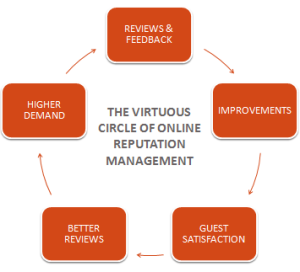64% of customers place more value on customer service than on pricing…This means that your potential customers would rather pay more for great customer service than pay less for a bad experience. Do your business values match those of your customers?
89% of customers who experience poor service will go somewhere else – you can control this! Ignoring customer complaints, as dreaded as this topic is, is the number one biggest mistake. Maybe you feel that a complaint is unjustified, or the customer is digging for a discount, or you figure you will fix the issue and that’s enough. Even when these is true, a response is still necessary to control future damage, and this is even more important today where word-of-mouth is online and has gone viral.
No matter what industry you are in, your reputation can have a major impact on your revenue and business. Follow these 5 steps to take control of your reputation and stop letting customers slip through the cracks!
Step 1: Reach Out to Your Customers!
We have all seen this happen – a customer has a bad experience, but isn’t confrontational, and so you know nothing about it until a week later when a bad online review surfaces. You may have been able to prevent this at the time, but now the damage is done. Don’t let this happen to you! Use every avenue available to you to ask for feedback and encourage reviews. Otherwise, how can you know what your customers are thinking?
This starts with in-person inquires. All personnel should be trained to encourage comments and recognize the signs of a potentially unhappy client. Simply by asking “How was your dinner tonight?” at checkout or saying “How are you feeling about your home construction experience?” can alert you to potential problems and even garner positive feedback. Back up in person inquiries with readily available comment cards or surveys, which are also helpful to build a customer database.
 Most of the world uses the internet, to leave reviews and read them. By giving your customers an online venue and asking for reviews, you gain the advantage of being able to respond to negative experiences, as well as encouraging positive reviews to help your reputation. Refer customers to places like Yelp, your business Facebook and your website and ASK them for feedback. And then follow up!
Most of the world uses the internet, to leave reviews and read them. By giving your customers an online venue and asking for reviews, you gain the advantage of being able to respond to negative experiences, as well as encouraging positive reviews to help your reputation. Refer customers to places like Yelp, your business Facebook and your website and ASK them for feedback. And then follow up!
Step 2: Listen Carefully!
Many unsatisfied customers can be calmed easily by having their complaints heard. Even if you feel it is unjustified, listen carefully to what they are saying, and ask questions to help get to the root of the problem. Avoid making excuses, and instead start by responding with a statement like “I understand why you are upset” or “Thank you for sharing your thoughts, we value your feedback”. If this is an in-person conversation, control the waterfall affect by making the conversation as private as possible. You may find that simply hearing your customer out changes their experience, and encourages them to return.
Don’t ignore online reviews, either intentionally or by being unaware! Get familiar with the review venues, like Yelp, Trip Advisor, and Google Places, and regularly check for new comments and ratings. Do online searches of your business name to see what people are saying, and again, listen attentively! You may feel like the damage is done and it’s out of your hands, but that’s not true!
Step 3: Identify Nature of The Complaint!
Some people are perpetually unhappy and voice so loudly, yet keep coming back. And there’s the guy who is looking for a discount or free product, even though there isn’t a genuine problem. Or maybe a disgruntled employee, out to intentionally sabotage your reputation, leaves a negative review. This is why it’s important to identify the nature of the complaint before responding.
In the event of a consistent complainer, taking the time to listen is the best solution. That’s usually all this type of customer is looking for. For the freebie guy, you want to try to avoid giving something away, but you have to be 100% sure that is the driving factor and not an actual complaint. Establishing a company policy can help with this, or offering a small discount to keep the problem from growing may be the answer. This is a decision you will have to make for your own business. Just make sure to not be confrontational or dismissive, because then the problem really is you!
If you suspect that a negative online review was left by a disgruntled employee, or perhaps a nasty competitor, take action immediately. Review sites like Trip Advisor and Yelp take this sort of thing very seriously, and will investigate and remove false complaints if you bring them to their attention. Don’t try to use this for legitimate complaints – this is a dishonest business move that no one will appreciate.
Step 4: Respond Promptly & Appropriately
 This is the most important factor in controlling your reputation! Whether in person or online, all complaints should be addressed as fast as possible. Avoid allowing your personal feelings to affect your response, and take a moment to get control if you need. Verbally attacking the complaining customer, or denying the accuracy of their feedback will just make the situation more explosive. It’s also important to avoid laying blame on someone else, as this is a bad business practice that doesn’t help.
This is the most important factor in controlling your reputation! Whether in person or online, all complaints should be addressed as fast as possible. Avoid allowing your personal feelings to affect your response, and take a moment to get control if you need. Verbally attacking the complaining customer, or denying the accuracy of their feedback will just make the situation more explosive. It’s also important to avoid laying blame on someone else, as this is a bad business practice that doesn’t help.
Explain what steps you will take to prevent future problems and how much you value the feedback. When appropriate, offer a discount or free product or gift certificate to encourage the customer to give you another try. Don’t use a prewritten blurb for each complaint – a personal response that restates the problem will have a bigger impact. By responding to online reviews, you show potential customers that you care about your customer service and are proactive about problems, and they may consider frequenting your business despite ratings.
This also applies to positive reviews – why wouldn’t you want to thank a customer for sharing their good experiences? It’s helpful to understand what people enjoy about your business, and by taking a moment to appreciate positive feedback, you can turn a one-time visitor into a regular client.
Step 5: Establish Consistency with Company Policies
Make sure all of your employees understand your dedication to good customer service by training them thoroughly on how to respond to complaints. Can you afford to lose business because of one uneducated employee? Proper training ensures reputation management consistency – if you give one complaining customer a discount and not the next, you must have an outlined reason for doing so that employees understand. It’s helpful to have one person responsible for responding to keep it professional.
By understanding how to manage your reputation and having a plan in place, you and your employees will be prepared to respond appropriately and promptly to reviews. Your customers will appreciate your attention, and your reputation will show this!
The Phelps Chamber of Commerce – Supporting Your Business!
The Phelps Chamber is dedicated to promoting our local business members and the Phelps community for the benefit of all. We know that running a small business can be difficult, and want to offer help wherever we can. Do you have a question or issue you would like to see addressed on the Phelps Chamber Blog? Let us know! Have further insight into a business topic we are discussing? Share your experience!





1 Comment